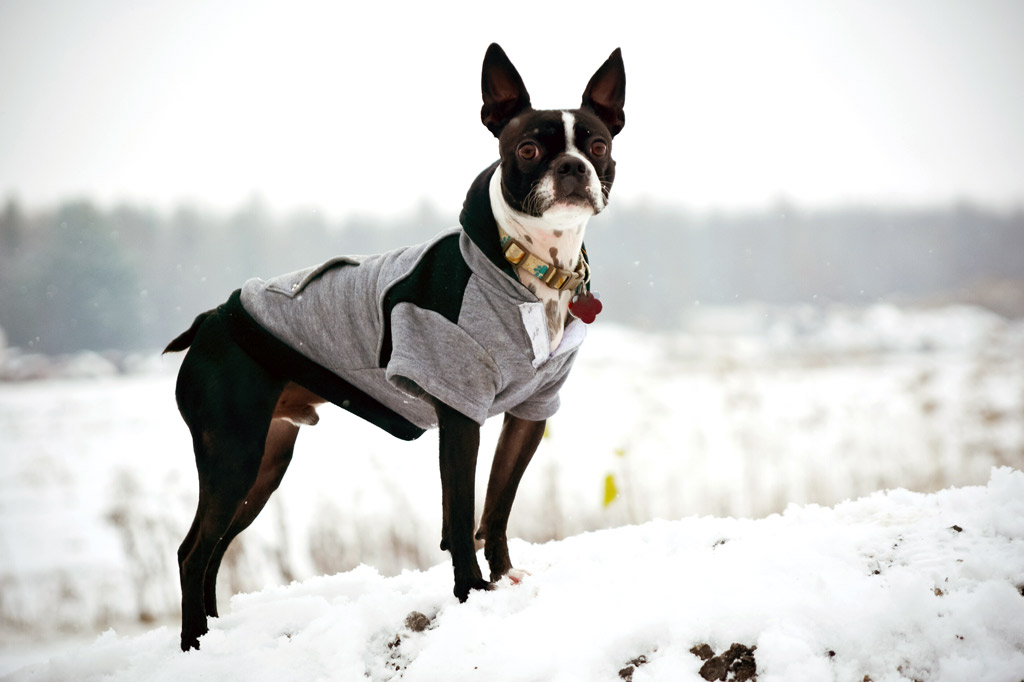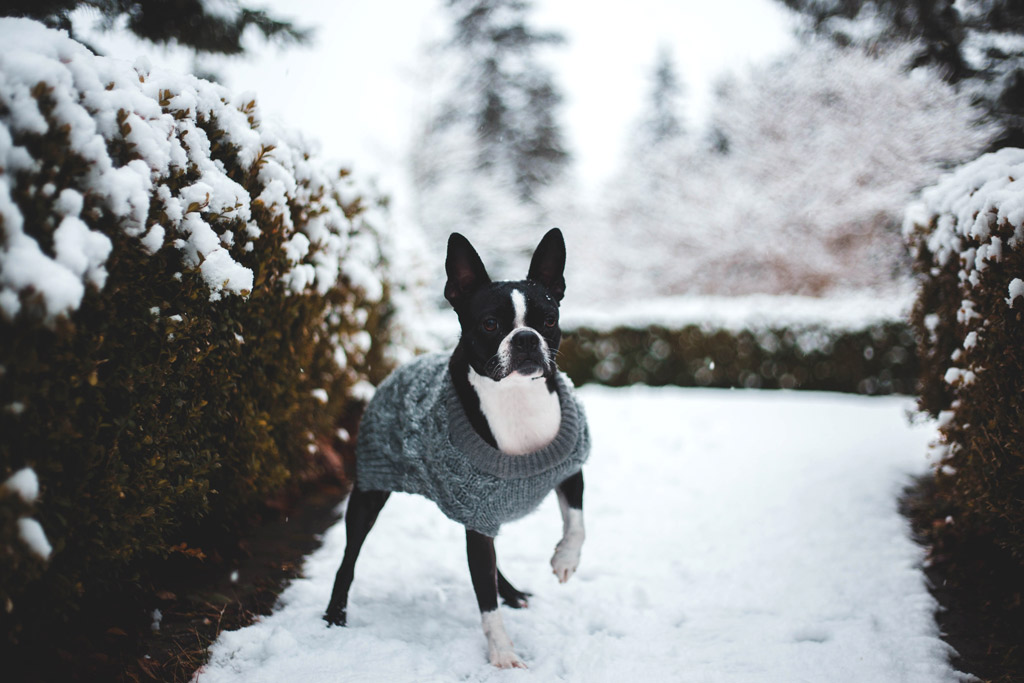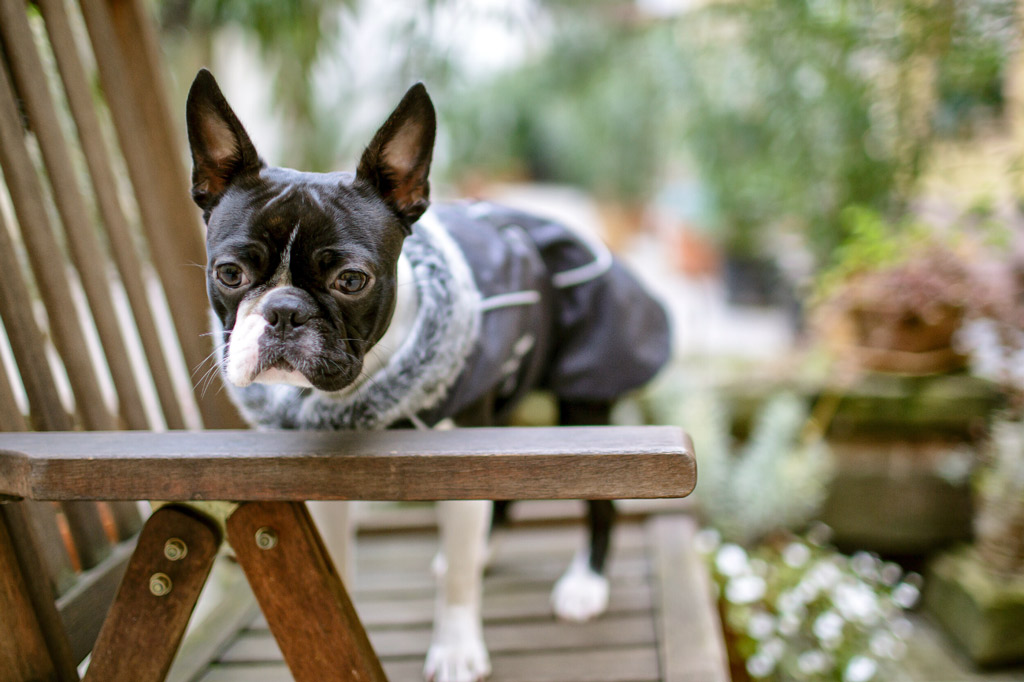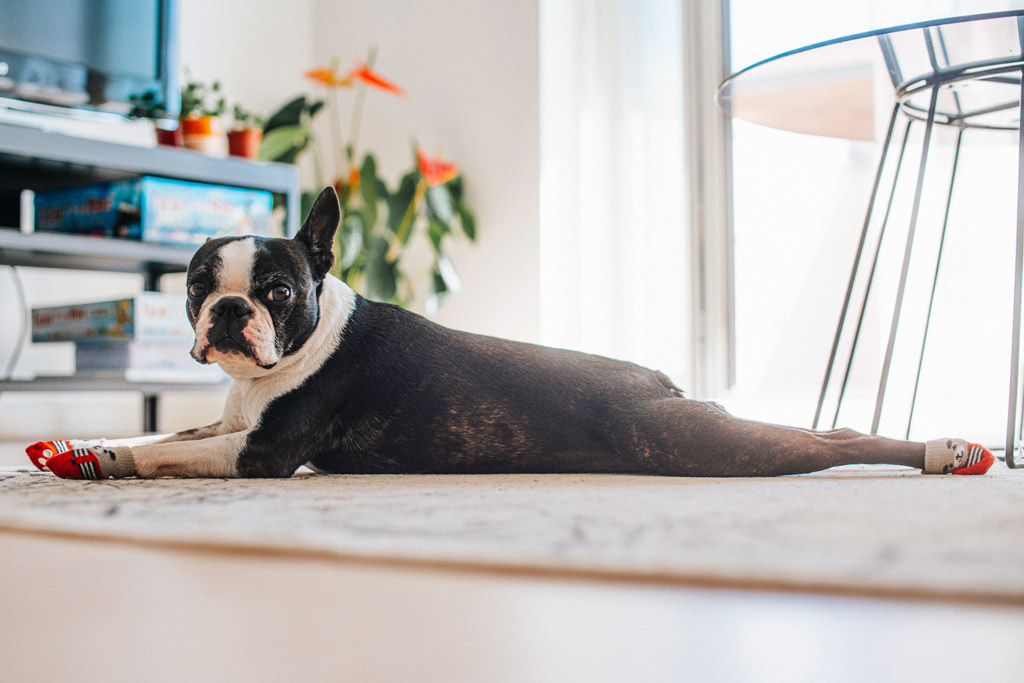
Boston Terriers are a playful breed who love to play both indoors and outdoors. However, would your Boston still want to go outdoors when the temperatures drop and snow arrives?
Do Boston Terriers like snow? It depends on your dog’s preferences and previous experiences with snow. The only way to find out is to introduce your pooch to the snow and see how she reacts.
Here are 5 tips for winter walks with your Boston Terrier. But before that, it’s a good idea to know about their tolerance for the cold.
Do Boston Terriers Like Snow?
The way your Boston reacts to snow can depend on many factors like:
- If fun and curiosity win over the cold.
- Previous experiences with snow.
- How you encourage and present snow to your dog.
Even if Boston Bull Terriers are playful canines, they get cold easily. This and the other factors can shape her decision.
Some will go romp around in it and you will find yourself dragging her back indoors. However, other Bostons will go out to potty and run back into the house to snuggle.
Regardless of your Boston being a fan of snow, you should always make sure that your pooch is warm and comfortable at all times. It won’t take your furry friend too long to get cold!
Boston Terriers don’t have much fur on the underside. Plus, their hair is short and relatively thin on the rest of their bodies. Because of this, they won’t be able to trap body heat.

Tips for Winter Walks
Your Boston will rely on you to prepare her for the colder months. Here are some tips to ensure that your pooch is protected, warm and happy during winter walks:
#1 – Keep Your BT Well-Exercised
It’s really important to maintain your Boston’s physical and mental condition year-round.
Don’t let the weather stop you and your pooch from exercising together!
If you allow your dog to become a couch potato all winter, you increase her risk of injury when she starts exercising again in the spring. Plus, your pooch will get bored and develop some destructive behaviours as a consequence.
For age-specific advice, you’ll find very useful tips in the How Much Exercise Do Boston Terriers Need? blog post.
Apart from walks, you can always keep your Boston Terrier active indoors, which is a great idea regardless of the weather. Use our Boston Terrier Activities and Dog Exercise Indoors resource guides for ideas on this.
#2 – Beware of Frostbite and Hypothermia
Exposing your pooch to different types of weather throughout the year can be helpful. Giving her multiple opportunities to explore different environments will expand her experiences and give her a chance to strengthen her tolerance.
However, protecting your dog from frostbite and hypothermia is key. Temperatures lower than 32 degrees Fahrenheit (0 degrees Celcius) can cause hypothermia or frostbite.
Here are the signs that your dog is uncomfortably cold:
- Whining.
- Shivering.
- Appearing anxious.
- Slowing down or stopping.
- Looking for a warm place to burrow.
Note: Boston Terriers with chronic disease, puppies and older animals are more vulnerable to the cold than healthy youngsters and adults.
Also, protect your pooch by having dog insurance. With Petplan pet insurance, you get the coverage, support and resources you need to be the best pet parent ever. Plus, it will help you save on vet bills! 🙂
Insider Tip: If possible, avoid exercising your Boston outdoors early in the morning or late in the evenings. The warmest time will be lunchtime or early afternoon, when the sun and the temperature are at their highest.
Read also: Boston Terrier Care in Winter – 8 Tips to Prevent Frostbite blog post.

#3 – Keep Your BT on the Leash
For your Boston’s safety, it’s best to keep her on the leash at all times during winter walks. Here some reasons why:
- To prevent your pooch from getting lost. Snow can easily disorient your pooch.
- To avoid your dog getting into a dangerous situation like getting in contact with antifreeze liquid – a single teaspoon of this can cause kidney failure.
- To keep your furry friend away from frozen water surfaces like ponds and lakes. Animals can easily fall through the ice, and it’s very difficult for them to escape on their own, or for humans to rescue them.
In case your pooch wonders out of view… I recommend Tractive, a GPS tracking device attached to your dog’s collar! This will allow you to locate your dog every time. 🙂
#4 – Keep Your BT Warm
Some dogs won’t allow you to put on clothing for them no matter how chilly they are. But if your Boston tolerates it well, dog clothes can help keep her warm when you take her outdoors.
For facing those cold winter months, you might want to consider:
- Keeping your dog warm on a sunny day: A knit sweater, a hoodie or a fleece.
- Proofing your pooch against the wind and rain: A classic poncho, a print raincoat or a waterproof coat.
Remember that due to Boston Terrier’s short hair, they get cold easily and are not able to stay warm by themselves for long!
Insider Tip: Dogs lose most of their body heat through the pads of their feet, their ears, and their respiratory tract. So there’s a limit to how much warmth a sweater or jacket will provide.
P.S. If you don’t know how to measure your pooch, we have an illustrative guide to help with this in Do Boston Terriers Need Sweaters?.

#5 – Protect Your BT’s Paws
There are a surprising amount of harmful things that a dog’s paws can pick up during winter:
- Rock salt.
- Ice.
- Antifreeze.
- And other toxic chemicals during winter.
So to prevent ingestion of toxins, thoroughly wipe off her feet, legs and underside after she’s been outside. Alternatively, give her a paw bath.
Also, as Boston’s paws can become chapped and raw because of the snow, you should regularly check your dog’s paws for any signs of injury or bleeding from walking on frozen or snow-packed surfaces.
Dog booties (Amazon link) can provide coverage and also prevent salt from getting lodged between bare pads, which causes irritation. Let your furry friend get used to booties gradually.
Although boots can be a great solution to protect your Boston Terrier’s paws, you might find out that your pooch won’t want to wear them!
That’s ok, you could use natural wax instead, like Musher’s (Amazon link).

